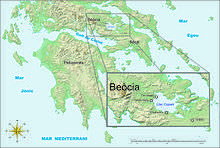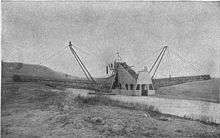Lake Copais
Lake Copais, also spelled Kopais or Kopaida (Ancient Greek: Κωπαΐς; Greek: Κωπαΐδα), was a lake in the centre of Boeotia, Greece, west of Thebes. It was drained in the late 19th century. The area where it was located, though now a plain, is still known as Kopaida. A one-time island in the lake was modified in ancient times into a megalithic citadel, now called Gla, though its ancient name is not known. It may be the city of Arne mentioned by Homer.

Drainage

When the lake existed, the towns of Haliartus, Orchomenus, and Chaeronea were on its shores. Rivers feeding the lake included the Cephissus, Termessus and Triton. The lake was (and is) surrounded by fertile land, but the lake increasingly encroached on the surrounding land because of inadequate drainage. In response to this, in 1867–1887 Scots and French engineers reclaimed the land for the British Lake Copais Company, by building channels to drain water from the lake to the Cephissus and from there to Lake Yliki (Ylíki Limní, ancient Hylica). In total about 200 square kilometres (77 sq mi) were reclaimed. This land was returned to the Greek government in 1952.[1]
The Kopais Lake Agency was created in 1957 to supervise the draining of the lake and building of a new road. The task was completed that same year, but the agency with full-time staff of 30 (including a driver for the president of the agency) still existed until 2010.[2][3]
Before this the lake drained into the sea by numerous subterranean channels. Some of these channels were artificial, as the 1st century geographer Strabo recorded.[4] Modern excavation has found enormous channels dug in the 14th century BC which drained water into the sea to the northeast;[5] Strabo mentions work being done on these channels by an engineer named Crates of Chalcis in the time of Alexander the Great.
Lake Copais in ancient literature and mythology

Homer and other ancient authors refer to Copais as the "Cephisian lake", named for the river Cephissus.[6] Strabo, however, argues that the poetic expression refers to the smaller Lake Hylice (the modern Lake Yliki), between Thebes and Anthedon.[7]
There was a legend that the lake came into being when the hero Heracles flooded the area by digging out a river, the Cephissus, which poured into the basin.[8] Polyaenus explains that he did this because he was fighting the Minyans of Orchomenus: they were dangerous horseback fighters, and Heracles dug the lake in order to unhorse them.[9] Another story has the lake overflow in the mythical time of Ogyges, resulting in the Ogygian deluge.[10]
The travel writer Pausanias and the 5th century BC comic playwright Aristophanes record that in antiquity Lake Copais was known for its fish, especially the eels.[11]
References
- "Buildings of the Installations of Copais Company", Hellenic Ministry of Culture, accessed 12/2011; "Mycenaean Gla", accessed 12/2011.
- "The 'Atimorisia' Illness: Greece's Toothless Battle against Corruption". Spiegel Online. Retrieved 11 April 2012.
- Manolopoulos, Jason (2011). Greece's 'Odious' Debt: The Looting of the Hellenic Republic by the Euro, the Political Elite and the Investment Community. Anthem Press. p. 288. ISBN 0-85728-771-0.
- Strabo 9.2.18.
- "Buildings of the Installations of Copais Company", Hellenic Ministry of Culture, accessed 12/2011; "Technology in Ancient Greece", accessed 12/2011.
- E.g. Iliad 5.708; Pausanias 9.24.1 makes the identification explicit.
- Strabo 9.2.20.
- Diodorus Siculus 4.18.7; Pausanias 9.38.7.
- Polyaenus Strategemata 1.3.5.
- Entry "Ogyges" in Oskar Seyffert, A Dictionary of Classical Antiquities, Revised and edited by Henry Nettleship and J.E. Sandys, New York: Meridian Books, 1956.
- Pausanias 9.24.2; Aristophanes Acharnians 880
External links
- Ghembaza, Therese (2012). "The Mysteries of Lake Copias and the Island of Gla". Therese Ghembaza.
- Strabo. "Geography". Perseus website. see especially 9.2.16-27 (translated by H.L. Jones, 1924)
- Pausanias. "Description of Greece". Perseus website. (translated W.H.S. Jones and H.A. Ormerod, 1918)
- Google Earth air view of the Lake Copais plain
- Google Earth ground view across the Lake Copais plain from the south
- Google Earth ground view across the Lake Copais plain from the east
- Wikimedia Commons